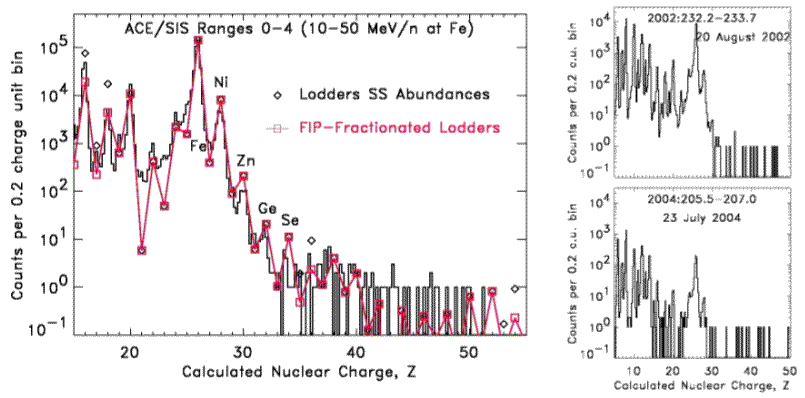
| ACE News Archives | ACE News #92 - Sep 28, 2005 |
Subscribe to ACE News |

Solar energetic particle (SEP) events are generally classified as either gradual or impulsive. Gradual events are typically large, with average composition similar to that of the corona, and are accelerated by shocks driven by coronal mass ejections. Impulsive events are smaller, highly enriched in 3He, and associated with flares. Recent measurements from Wind/LEMT by Reames & Ng and ACE/ULEIS by Mason et al. (ACE News #81) show that abundances of ultraheavy (UH) elements (Z>28) can be overabundant relative to oxygen by factors of ~100 to 1,000 in impulsive SEP events at energies of several MeV/nucleon. It is of interest to extend these measurements to higher energies (>10 MeV/nucleon) where even large gradual events are often very iron rich and may appear similar in composition to impulsive events, in order to test models of acceleration and abundance enhancements in both gradual and impulsive events. The Solar Isotope Spectrometer (SIS) on ACE is primarily designed to measure the isotopic composition of He (Z=2) through Ni (Z=28) at ~10 to ~100 MeV/nucleon, but it also has limited elemental sensitivity above Z≈40. So far, SIS has recorded ~1000 nuclei with Z≥29, including measurable quantities of Zn, Ge, and Se (Z=30, 32, and 34); however work still needs to be done to properly calibrate the instrument's UH response to obtain absolute abundances.
Although not optimized for UH measurements, SIS attains excellent elemental resolution in this regime, as shown in the left histogram, which was accumulated since launch in August 1997 through June 2005. For comparison, the solar system abundances (normalized to Fe) from a recent compilation by Lodders are shown. Since solar wind and SEPs tend to be underabundant in elements with a high first ionization potential (FIP), we also show the solar-system abundances after accounting for FIP fractionation by reducing the abundances by a factor of 4 for elements with a FIP >10 eV. The data are raw counts summed over many SEP events, both very large and small, without accounting for reduced UH detection efficiencies or converting to absolute fluxes. The tendency for the histogram to be slightly higher than solar system abundances for elements lighter than Fe and slightly lower for heavier elements is an expected consequence of the SEP energy spectra and the measurement technique. Apparently the long-term average composition of ~10-50 MeV/nucleon ions out to at least Z=40 agrees reasonably well (within a factor of ~2) with standard solar-system values.
UH abundances are highly variable from one impulsive event to the next, as shown in the histograms at the right. Note that the number of particles above Z=34 is comparable in the two events, even though the Fe (Z=26) peaks differ in intensity by a factor of ~50. At 12-60 MeV/nucleon, the Fe/O ratio in the July 2004 event is ~0.76, about half that of the August 2002 event (1.75), and the Fe spectrum is very soft, with a power-law index of -4.7. These observations are consistent with the lower-energy Wind/LEMT study that found the largest UH enhancements in events with very soft Fe spectra, and no correlation between Fe/O and UH enhancements.
Simply totaling the counts in the July event between Z=34 and 40 and normalizing to solar abundances, without correcting for different energy intervals, reduced UH efficiency, or FIP fractionation (all of which would increase the enhancement) yields a (34≤Z≤40)/O enhancement of ~250-300! This is more than 10 times larger than the maximum reported for a gradual event and similar to the largest impulsive value in the Wind/LEMT study at 3.3-10 MeV/nucleon. The UH abundance enhancements in impulsive events are similar on average to the 3He enhancements, and remain a challenge to explain theoretically.
Submitted by Rick Leske of Caltech. Address comments or questions to ral@srl.caltech.edu.
Last modified 28 Sep 2005, by